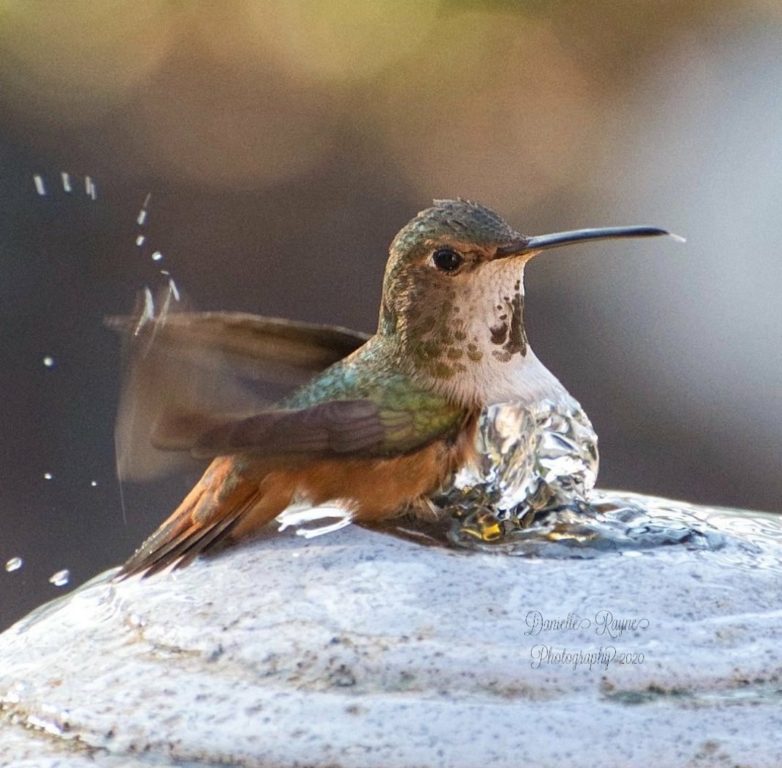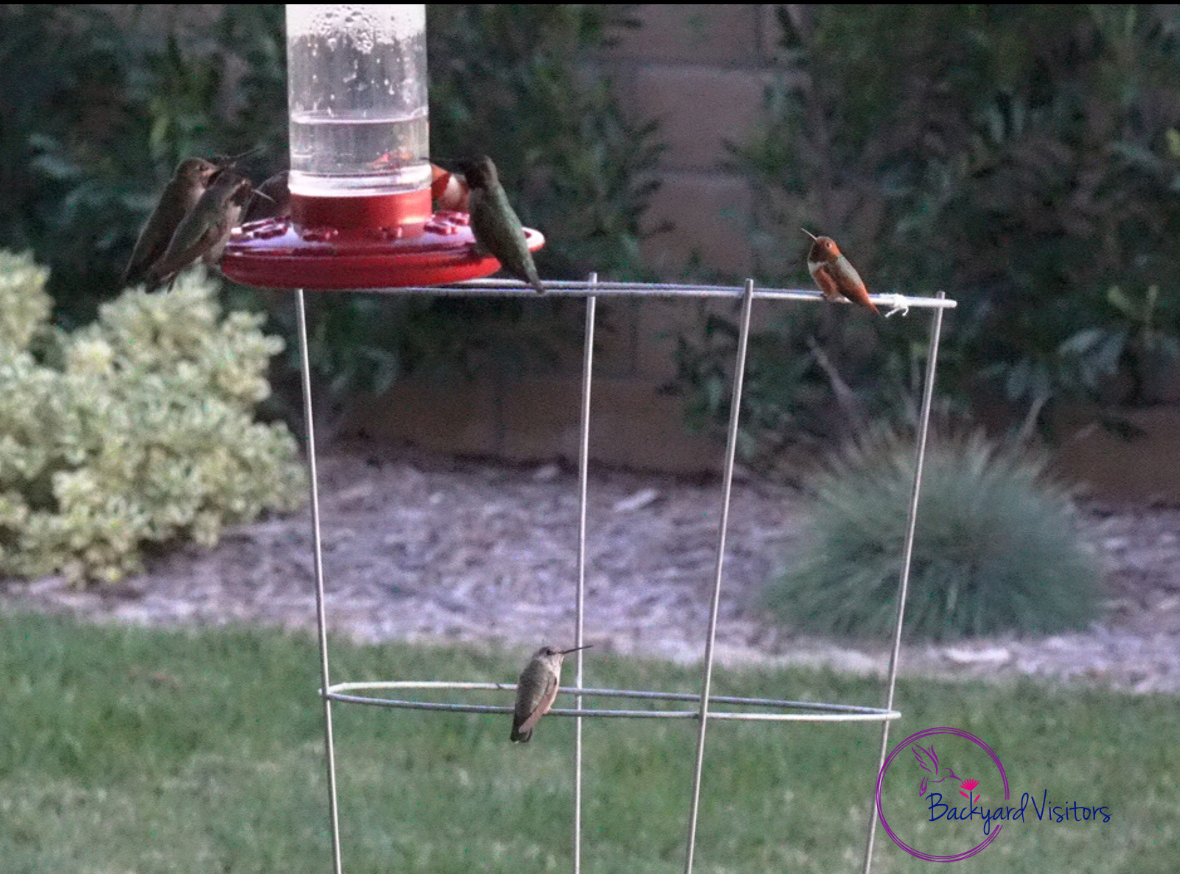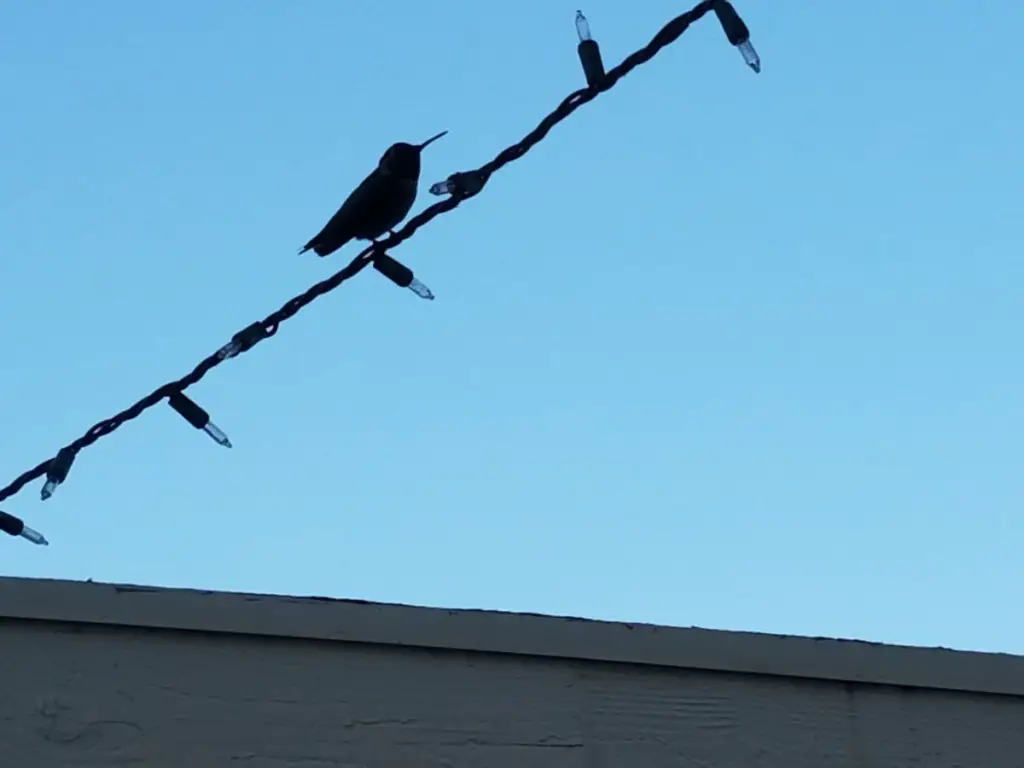This post contains affiliate links.
Here is a hummingbird so happy with its bath that it almost fell asleep!
Hummingbird baths are customized products designed specifically for hummingbirds.
After doing some research, I recently purchased a hummingbird bath that met the specific criteria needed for a hummingbird bath. I outline the customary criteria in this article.
During my research, I discovered one additional very interesting fact.
Hummingbirds, unlike all other birds, do not take dirt or dust baths.
What kind of bath do hummingbirds like?
Hummingbirds are attracted to brightly colored, shallow hummingbird baths with water features like sprays and bubblers. Proper placement away from predators ensures a favorable habitat for these enchanting creatures.
Regular cleaning of the hummingbird bath is necessary to keep the water safe.
Let’s understand why hummingbirds need access to clean water. Most birds get their hydration needs met by drinking plain water.
Hummingbirds get their hydration by drinking the nectar from tubular flowers they visit regularly, or by drinking the sugar water from hummingbird feeders.
However, they do need water for bathing and cleaning their feathers, which is their primary use of a hummingbird bath or fountain. Hummingbird baths and fountains not only provide a place for them to wash away debris but also help them distribute the oil from their preen glands to coat their feathers, which keeps them warm and helps with flying.


Hummingbirds have a special attraction to hummingbird fountains with a bubbler gently gushing water from atop a spherical shape.
There are essential features to consider when deciding on a hummingbird bath. Bright colors, especially red, which denotes the availability of nourishing nectar for a hummingbird, are attractive to them.
Pick a hummingbird bath with vibrant hues that mimic the hummingbird’s own bright plumage or the color preferences they have for the nectar flowers.
Also, plant vibrant flowers nearby to get their attention.
Bear in mind that hummingbirds are petite; therefore, a shallow bath is an essential choice for them.
In lieu of providing a specific hummingbird bath, a regular birdbath can be acceptable by adding stones, rocks, gravel, or even marbles, making it no more than ½ inch deep. Adding water features like bubblers, misters, and drippers will make the converted regular bird bath even more appealing to hummingbirds.
It’s also essential to offer hummingbirds perches for preening and drying after they bathe. Perches give them a place to rest, groom, and feel safe.
I find my hummingbirds love to perch on my tomato cages, but they also like to perch on my patio light string. I think they like the swinging motion.


Hummingbird baths need to be cleaned routinely as part of maintenance. Regularly empty and clean the basin. Do not use bleach. It is toxic for all birds. Distilled vinegar and water are a superior and safe solution to clean and maintain your hummingbird bath.
Safety is always a priority when deciding where to place your hummingbird bath. If you intend to use an electric water feature, locate it close to a power source at ground level or a foot or two above the ground.
To prevent excessive evaporation, place the hummingbird bath in a location that will provide adequate shade.
Lastly, be mindful of potential predators. Place the bird bath in a low-traffic area away from pets and curious visitors. Adding nearby shrubs or hiding spots will give hummingbirds a safe retreat if they feel threatened.
By creating an inviting and safe environment, you’ll be treated to a delightful experience that is only observable by having a hummingbird bath feature in your backyard.
Do hummingbirds need a water bath?
Hummingbirds require a water bath primarily for grooming. Their hydration needs are satisfied by consuming the water content of the flower nectar. During dearth, water baths can provide additional hydration needs, as can hummingbird feeders.
Included in their hygiene routine is cleaning their beaks, feathers and discarding any mites they may have picked up during their flights from flower to flower.
Hummingbirds are also attracted to standard bird baths; however, they are unsafe for these tiny birds. They require shallow baths with miniature rims for safety. They are skilled at holding onto the hummingbird bath’s edge, which makes it easy for them to perch and take baths.
Regular birdbaths are too deep, and the rim is too big for hummingbirds. That puts the hummingbird at risk of drowning.
They are attracted to shallow, light, bubbling water where they are able to stand and dip while preening their feathers.
Some multi-level bird baths designed for small birds have a top and secondary component that works well for hummingbirds, but the bottom section usually requires adding rocks, stones, or marble to bring the water depth to no more than ½ inch deep to prevent accidental hummingbird drowning.
You can also find commercially made hummingbird misters that attach to a garden hose, providing a gentle mist that these little birds enjoy.
Hummingbirds’ water needs for survival are primarily met by drinking nectar from flowers; however, they have additional ways to quench their thirst.
In areas with morning dew, they sip the tiny droplets on leaves and flowers. They also drink water from hummingbird baths and take advantage of rainstorms that produce puddles of water.
See my article: Hummingbird Adaptations in Rain: Mastering the Elements
During drought conditions, there is a decrease in wildflowers, leading to a scarcity of nectar for hummingbirds to feed on. Additionally, fewer insects hatch, which means there is a limited supply of protein available to them. This combination of factors can put stress on the hummingbird population.
To support our feathered friends during a drought, it’s recommended to provide them with a water source alongside their regular feeders. This can help them stay hydrated and maintain their health during challenging times.
If you want to attract and help these delightful creatures thrive, consider setting up a shallow bath with a miniature rim or a hummingbird mister in your backyard. It’s not just fun to watch them bathe and play, but it also ensures their well-being, especially during dry periods.
It is advised to give our feathery companions a water source in addition to their regular food sources to help them survive droughts. This can assist them in maintaining their health and hydration during trying times.
How deep should a hummingbird bath be?
The water level in a hummingbird bath must be no more than ½ inch (1.27cm) deep, as anything deeper poses a risk of drowning for the hummingbird. They are attracted to soft, running water with a bubbler.
Ideally, the bubbler is on top of a sphere that has ridges so that the hummingbird is able to perch.
Hummingbirds are unusually tiny creatures, and they have particular preferences for where they like to bathe and drink.
Hummingbirds prefer shallow water, first and foremost. Unlike other birds, they do not splash around and take a bath in deep water.
In order to allow them to dip their beaks and wings, your bath should be a maximum of ½ inch (1.27 cm) deep with a textured surface for the birds to sit on and bathe.
Hummingbirds dislike stagnant water; therefore, hummingbird baths should provide gentle running water, a light spray, and the additional feature of a bubbler will be a big plus.
Hummingbirds also enjoy sphere-shaped fountains with a bubbler at the top.
Providing a suitable hummingbird bath or fountain will attract hummingbirds to your backyard for your viewing pleasure.
Will hummingbirds come to a standard bird bath?
Hummingbirds should not and generally will not come to a standard bird bath.
Regular bird baths are too deep, and hummingbirds can drown.
Hummingbirds are attracted to gently moving water sources. Provide them with shallow, bubbling, slow-moving, misting, or dripping clean water, and they will come.
Hummingbirds obtain almost all of their hydration needs from the nectar they consume from flowers. They are attracted to hummingbird baths primarily to groom their feathers and beaks. This grooming activity requires a customized hummingbird bath that has a depth of water no more than 1/2 inch or a standard birdbath whose base has been filled with rocks, stones, or marbles so that the water depth is no more than 1/2 inch in depth.
Hummingbird baths are not only tailored in their depth but also have features like running water, bubblers, sprayers, misters, and small rims for the hummingbirds to easily perch on.
In lieu of having a hummingbird bath, an option is to use a water mister that attaches to a garden hose and produces a fine mist of water that hummingbirds can fly through or hover in to moisten their feathers.
Hummingbirds will ignore a standard birdbath unless the birdbath has several tiers and the very top tier has a bubbler.
Weeping-style fountains are also great for hummingbirds. These fountains have a thin sheet of water moving over a textured surface, such as a piece of rough pottery or a weeping rock.
The water is shallow, so it’s safe for the tiny visitors. Sprinklers can work too. Some brave hummingbirds may fly through the aerial sprays for an in-motion bath.
Regardless of the water source you choose, it’s a good idea to have multiple perches nearby for the wet hummingbirds to rest and preen. This way, they can recover comfortably after their baths.
They particularly like to perch on my tomato cages.

Remember, just like with traditional bird baths, it’s crucial to keep these water sources clean and safe for the birds. Regular maintenance and cleaning will prevent any contamination from feces, dirt, or debris.
Oh, and one more thing! These water features won’t just attract hummingbirds. Other wildlife like butterflies, bees, moths, and various birds may also drop by for a refreshing sip. So, it’s like you’ll be creating a little ecosystem of thirsty visitors in your backyard!
In summary, while hummingbirds might not use traditional bird baths, they’ll surely appreciate your efforts to provide them with the right kind of water sources. By using misters, drippers, fountains, or sprinklers, you can give these delightful little birds a perfect spot to freshen up and stay cool in your backyard!
Check out my other posts on Hummingbird Questions
Enjoy Watching Your Hummingbirds Bathe and Preen!
Backyard Visitors participates in affiliate programs which compensate us for referring traffic.

